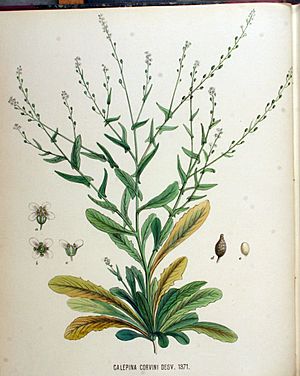Leiocarpaea facts for kids
Leiocarpaea cochlearoides is a fascinating plant that belongs to the Cabbage family. This plant used to be known as Bunias cochlearoides. It's usually a perennial plant, meaning it lives for more than two years. Sometimes, though, it can be biennial, living for two years. It's an herbaceous plant, which means it has soft, green stems rather than woody ones like trees.
Contents
What is Leiocarpaea cochlearoides?
This plant is a unique member of the Brassicaceae family, also known as the mustard or cabbage family. It's not as well-known as some of its relatives, but it plays an important role in its natural habitat. Scientists gave it the new name Leiocarpaea to better group it with similar plants.
Where Does This Plant Grow?
Leiocarpaea cochlearoides prefers certain environments to thrive. It often grows in areas with specific soil types and climates. These plants are usually found in wild, open spaces. They might grow in meadows, along roadsides, or in disturbed ground. Its ability to grow in different places helps it survive.
What Does Leiocarpaea Look Like?
This herbaceous plant typically grows to a moderate height. Its leaves are often green and can vary in shape. The plant produces small flowers, which are usually yellow or white. These flowers have four petals arranged in a cross shape. This cross shape is a common feature of all plants in the Cabbage family. After flowering, the plant forms small seed pods. These pods hold the seeds for the next generation of plants.
Its Place in the Cabbage Family
The Cabbage family, or Brassicaceae, is a very large group of plants. It includes many vegetables you might eat every day. Think about broccoli, cabbage, cauliflower, and radishes. All these popular foods are relatives of Leiocarpaea cochlearoides.
Why is it Called the Cabbage Family?
The name "Cabbage family" comes from the many well-known vegetables in this group. Another name for it is the "mustard family." This is because many plants in this family, like mustard greens, have a slightly spicy taste. A key feature of these plants is their flowers. They have four petals arranged like a cross. This is why the family is also sometimes called "Cruciferae," which means "cross-bearing."
How Does Leiocarpaea Grow?
Understanding how a plant grows is part of its life cycle. Leiocarpaea cochlearoides can be either perennial or biennial. This means it has different ways of completing its life.
Perennial Life Cycle
When Leiocarpaea is perennial, it lives for many years. It grows from seeds, flowers, and produces new seeds each year. Then, its roots and base survive the winter. New growth appears again in the spring. This allows the plant to keep growing and spreading for a long time.
Biennial Life Cycle
Sometimes, Leiocarpaea acts as a biennial plant. This means it completes its life cycle in two years. In the first year, it grows leaves and stores energy. It usually doesn't flower. In the second year, it uses that stored energy to grow tall, flower, and produce seeds. After producing seeds, the plant dies.
How Does Leiocarpaea Reproduce?
Like most flowering plants, Leiocarpaea reproduces using seeds. The flowers are pollinated, often by insects. After pollination, the plant develops seed pods. These pods contain tiny seeds. When the seeds are ripe, they fall to the ground or are carried by wind or animals. If they land in a good spot, they can sprout and grow into new plants. This process ensures the plant's survival.
Why Did Its Name Change?
Plant names can sometimes change. This happens when scientists learn new things about plants. They study their DNA and how they are related.
Understanding Plant Names
Every plant has a scientific name, like Leiocarpaea cochlearoides. This name has two parts. The first part is the genus, which is like a family name for plants. The second part is the species, which is specific to that plant. Using scientific names helps scientists all over the world know exactly which plant they are talking about.
The Reason for the Change
Originally, Leiocarpaea cochlearoides was placed in the Bunias genus. However, new research showed that it was actually more closely related to other plants. Scientists found that its characteristics, especially its seeds and fruits, were different from other Bunias species. So, they moved it to a new genus called Leiocarpaea. This change helps to make the plant classification more accurate. It shows how different plants are truly related to each other.


